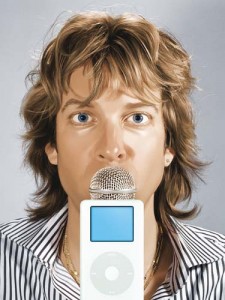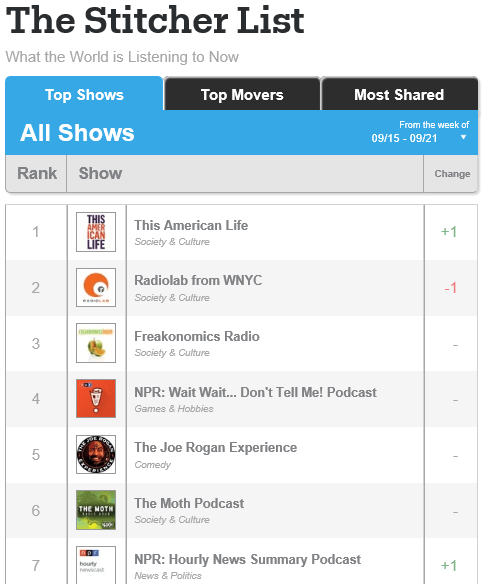If you’ve been closely following tech trends over the years, you know that there are times when innovations take a while to take hold with the public. Some of them – like QR Codes, for example – never seem to catch on.
Visionary Clive Dickens always advises tech entrepreneurs to be patient when it comes to new start-ups and trends. He knows this from experience as one of the early investors in Shazam. While it may have been in the initial wave of apps you downloaded when you bought your first smartphone, the fact is that Shazam was founded 15 years ago, and has still not become an absolutely breakaway hit.
It takes time.
 And so might be the case with podcasts, a concept that’s been around for a decade, but continues to try to achieve mainstream success. You may recall that former MTV VJ Adam Curry (pictured at left) was credited with the automated delivery of podcasts to devices like iPods. That was a long time ago.
And so might be the case with podcasts, a concept that’s been around for a decade, but continues to try to achieve mainstream success. You may recall that former MTV VJ Adam Curry (pictured at left) was credited with the automated delivery of podcasts to devices like iPods. That was a long time ago.
Podcasting has struggled to become a major part of the audio lexicon. Maybe some of this has to do with the name – derivative of “broadcasting” and “pod” from the original iPod. Many agree that the name itself just doesn’t describe the full scope and capabilities of this medium.
The on-demand nature of podcasting has always been its killer app, so to speak. And we know that on the television side, on-demand has become the primary way that many of us now consume programs and shows. From the early days of TiVo to the DVRs that are now built into our cable and satellite TV services, fewer people are watching television in real time, opting for the convenience of on-demand.
We often talk about “appointment listening” in radio, especially since the PPM Era began. PDs often think this means directing listeners to join us for an important piece of programming or a promotion at a specific time – on our schedule – not the listener’s.
But the world of podcasting is all about appointment listening – on their schedule. And that’s why on-demand has so much potential to succeed.
So it comes down to that $64,000 question about which content is worth setting aside time to listen, and how it will be delivered. Public radio has been way out in front of the podcasting movement, largely because so much of its content is deemed worthy of listening to at a later, more convenient time. The list at left from Stitcher (which promotes itself as “The Future of Radio”), a podcast aggregator, shows a w eekly ranker from earlier this fall, with public radio shows from “This American Life” to WNYC’s “Radiolab” to NPR’s “Wait Wait…Don’t Tell Me!” always at or near the top.
eekly ranker from earlier this fall, with public radio shows from “This American Life” to WNYC’s “Radiolab” to NPR’s “Wait Wait…Don’t Tell Me!” always at or near the top.
And speaking of Stitcher, the value of podcasts is now playing out in a public dispute with Norm Pattiz’s “Podcast One.” The question of who owns the content and the right to distribute it is at the center of the conversation. The fact that this space is being vigorously debated underscores the value of the content.
Edison’s Tom Webster is well aware of how podcasting has caught on. He notes that a deeper dive into the numbers reveals that podcasting is becoming an amazing phenomenon:
“The behavior that really gets understated is not the growth in the overall audience for podcasts (the monthly reach for the medium grew 25% year over year, according to our Infinite Dial studies), but the sheer volume of podcasts that the average podcast listener consumes. In fact, according to our most recent Share of Ear study, if you are a daily podcast listener, 26% of your overall audio consumption comes from podcasts—that’s just behind AM/FM radio, which has a 28% share of ear with podcast consumers. That’s a sign that not only the medium is becoming more popular—but the amount of quality content is getting bigger and bigger.”
And this year, it appears the podcast code has been cracked. Like many new innovations, media, or programming offerings, it often takes one big success story to create mass interest. I think of “The Sopranos” as that moment for HBO and other premium channels, Howard Stern for both FM morning radio syndication as well as satellite radio, and “House of Cards” for Netflix and other services that are new to program development but have massive distribution.
And so it may be for podcasts because of “Serial,” a new audio programming sensation that is generating a lot of powerful word of mouth that puts it in the league with TV shows like “Homeland” and “Breaking Bad” during their impressive first seasons.
The New York Times’s David Carr calls the show “Podcasting’s First Breakout Hit,” averaging more than 1.5 million listeners per chapter. Produced and created by the WBEZ/Chicago “This American Life” team, “Serial” is a clever concept – a weekly one hour podcast show that is based around a cold murder case. One of the things that makes “Serial’ so special is that it is produced and presented in the same unique, staccato format as “This American Life.” The difference is that while “This American Life” tells a story about real people in real situations, “Serial” is total fiction.
And it’s good.
I put it to the test during a long cross-country drive last week, binge listening to three consecutive “Serial” installments before I finally had to start focusing on bad weather and weird traffic. “Serial” is riveting, and it tells a great story in a more dynamic way than any “talking book” does.
The New York Times is convinced t hat “Serial” is that tipping point for podcasting, perhaps unleashing a torrent of similar shows and more podcasts. From Stitcher to Norm Pattiz, you have to believe that many others are banking on podcasts to have a breakout year in 2015.
hat “Serial” is that tipping point for podcasting, perhaps unleashing a torrent of similar shows and more podcasts. From Stitcher to Norm Pattiz, you have to believe that many others are banking on podcasts to have a breakout year in 2015.
How broadcast radio – especially commercial stations – will respond to the podcast wave is both the challenge and the opportunity. Simply recycling the morning show by offering replays by the hour or the bit isn’t truly taking advantage of podcasting’s potential. Creating proprietary content that’s interesting, compelling, and bite-sized seems so much closer to realizing podcasting’s promise.
In this context, commercial radio would do well to take copious notes about how public radio has pulled off the podcasting transition. Our sixth Public Radio Techsurvey earlier this year indicated that there are some public stations where nearly a tenth of their overall consumption is now coming from podcasting. That represents a substantial share of the audience’s time that may – or may not – be monetized.
And then there’s the other rub.
“Serial” is sponsored by MailChimp and Squarespace, and apparently has asked for donations – a very public radio way to pay the bills. But like so many other digital assets, simply aggregating an audience is no guarantee of profitability. Measurement of podcasts in a way the advertising community can embrace goes to the heart of podcasting’s ultimate ability to provide content creators with a bona fide revenue source.
For broadcasters, podcasting could become a form of NTR – or “non-traditional revenue” at a time when ad dollars are increasingly difficult to come by. Podcast revenue that doesn’t come in from the traditional spot load represent great potential IF broadcasters can develop a true stable of talent capable of producing must-hear audio.
So much of what has happened since the turn of the century has been about consumers rekindling a love affair of audio. That transcends broadcast radio, and takes users into satellite, pure-plays, music collections and playlists, and of course, podcasts.
The good news for traditional broadcasters is that many people are making more time for audio related entertainment and information, especially while they’re on the go and using mobile devices. And many radio stations have the basic ingredients to create a successful podcasting model, including trusted and popular personalities.
On NPR’s “Weekend Edition Sunday,” correspondent Jon Kalish discussed the rising appeal of podcasting. He quotes PodTrac CEO Mark McCreary, “Advertisers know that what the audience likes about the podcasts is in a big way the host of the show. And so to to hear what the host of a show thinks about their product or service makes a big impact.” If that sounds like a familiar business model, then you can understand just how similar the podcast model is to the legacy radio advertising platform.
The less-than-good news is that with all this ado about podcasting, radio broadcasters – who should have a leg up in this space – find themselves wondering how this opportunity could elude them and what it will take to achieve success. Just re-purposing today’s morning show in podcast form won’t do justice to the potential that this medium represents. The question of how legacy radio companies will adapt to this growing need for original, on-demand content goes to the core of the challenge and the opportunity.
Public radio is proving the model can work from a popularity standpoint. But they, too, are struggling with the notion that listeners are choosing podcasts over on-air, real-time radio programming.
For commercial broadcasters, the questions are similar. Can they produce worthy content and generate the revenue to pay for it?
Stay tuned.
Correction: Several blog readers pointed out to me that “Serial” is in fact based on a true story and is not fiction. Thanks for the “reality check.”
- What To Do If Your Radio Station Goes Through A Midlife Crisis - April 25, 2025
- A 2020 Lesson?It Could All Be Gone In A Flash - April 24, 2025
- How AI Can Give Radio Personalities More…PERSONALITY - April 23, 2025




Leave it to my millennial son who came home from college over thanksgiving, and introduced his “radio” dad to what NPR is up to. When he shared the Public Radio app with me I was totally impressed. Now here are some broadcasters who truly get how to creatively transition from traditional terrestrial radio broadcasting to truly “user” directed content. I can get local new, in depth, national news and teach the app what kinds of stories I am most interested in. Then just click it on when I am ready, and hear news that interests me. Podcasting the morning show is still a long way from creating user directed content on demand.
Ric, public radio in general and NPR specifically are ahead of the curve in bith content creation and digital distribution. In thinking you’re talking about the NPR One app which provides a very interesting experience for public radio fans and their smartphones. Thanks for sharing the story.
“The difference is that while ‘This American Life’ tells a story about real people in real situations, ‘Serial’ is total fiction.”
“Serial” is not fiction. It’s longform reporting.
Brian, thanks. I corrected the post, but appreciate you pointing it out.